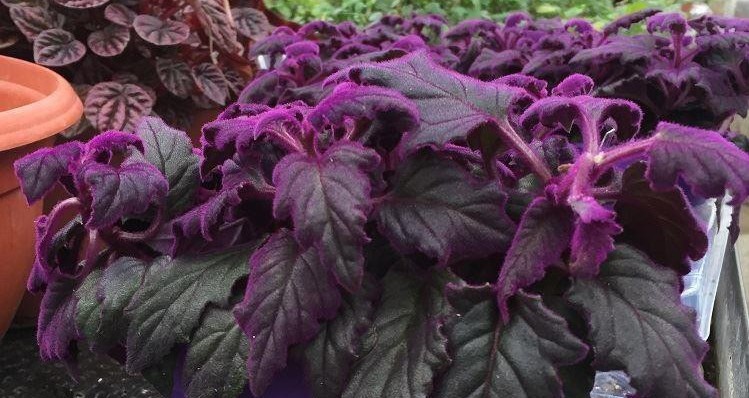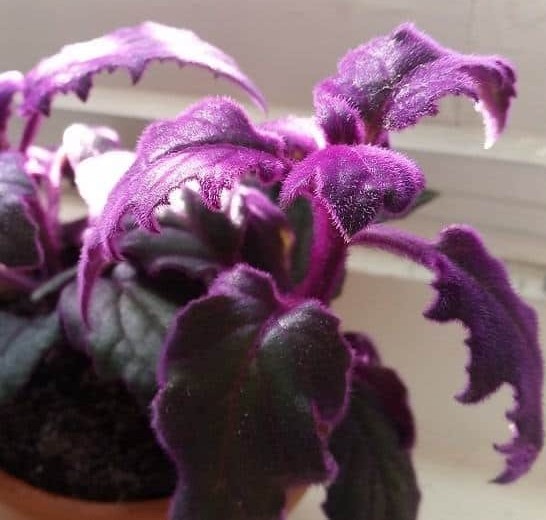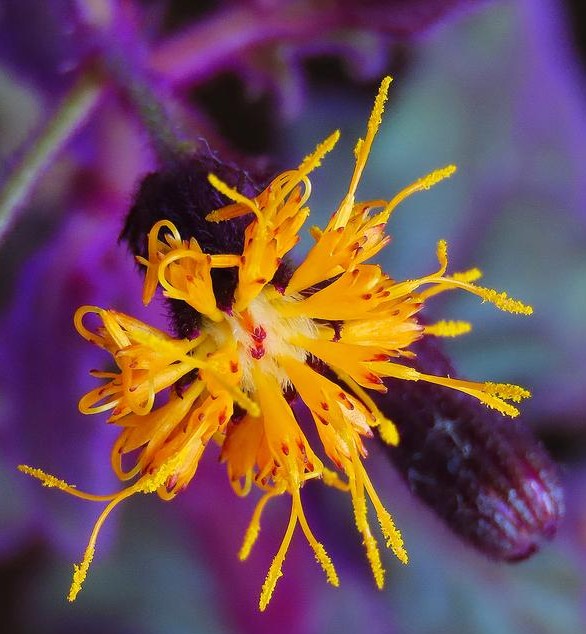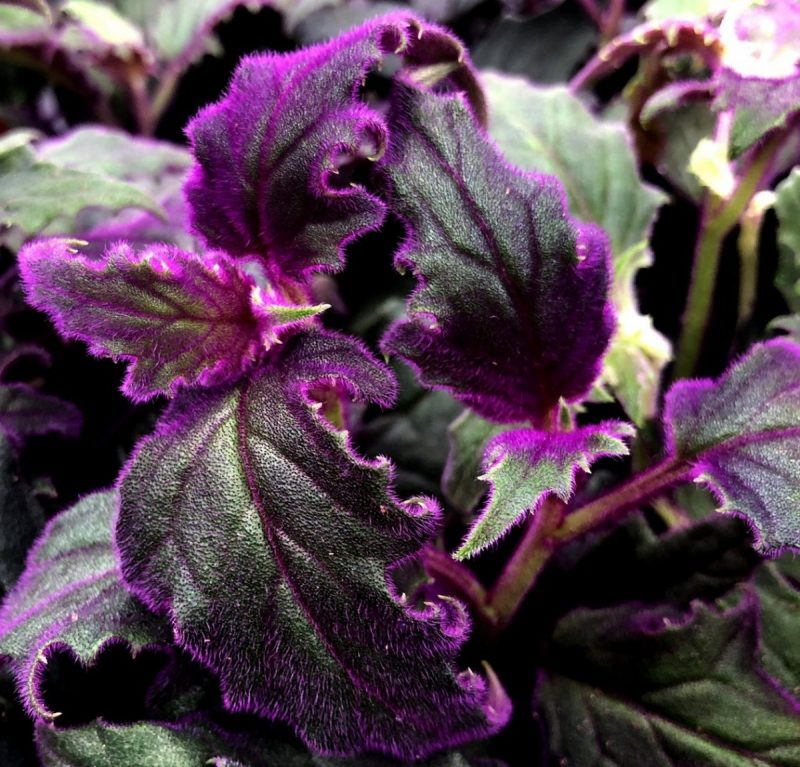Gynura, plant care and growing guide

Gynura is a genus of herbaceous, flowering plants in the Asteraceae family, native to East Asia and Indonesia. It is often used as an indoor decorative plant. In pots, it can grow up to 20-40 cm in height and width and it has a longevity of 2-3 years, after which it loses its decorative appearance.
Gynura aurantiaca is the only species used as a decorative plant, together with Gynura sarmentosa. It has dark purple leaves that are 10-20 cm long, with an oval shape and serrated edges, covered with a dense fuzz. The flowers appear in autumn and winter, they are yellow, with a diameter of 1-2 cm, similar to those of the common dandelion. They should be removed because of their unpleasant odor.



Light. It prefers strong, filtered light so as to not damage the leaves. In winter, it should be placed next to a well-lit window.
Temperature. Gynura has an optimal growth at a temperature of 20° C and it does not tolerate temperatures lower than 13° C.
Humidity. It grows easily in a dry atmosphere, but at temperatures above 20° C, the pot should be placed on a layer of damp gravel.
Substrate. The substrate must drain the water very well, and it can be made up of gravel, soil for Ericaceae, and a small part of organic compost. To improve drainage, it is advisable to put a layer of fine gravel at the base of the pot.
Recommended products
-
You can find products on a different store
Change Store -
You can find products on a different store
Change Store -
You can find products on a different store
Change Store -
You can find products on a different store
Change Store -
You can find products on a different store
Change Store -
You can find products on a different store
Change Store -
You can find products on a different store
Change Store -
You can find products on a different store
Change Store -
You can find products on a different store
Change Store -
You can find products on a different store
Change Store -
You can find products on a different store
Change Store -
You can find products on a different store
Change Store -
You can find products on a different store
Change Store -
You can find products on a different store
Change Store -
You can find products on a different store
Change Store -
You can find products on a different store
Change Store -
You can find products on a different store
Change Store -
You can find products on a different store
Change Store -
You can find products on a different store
Change Store -
You can find products on a different store
Change Store -
You can find products on a different store
Change Store -
You can find products on a different store
Change Store -
You can find products on a different store
Change Store -
You can find products on a different store
Change Store
Watering. Due to its very thin roots, Gynura should not be watered very often, as they can rot easily. During the summer, watering should be done so that the soil stays moist, but not too wet. In winter it should be watered less often.
Fertilization. During the vegetative growth period, a universal fertilizer for plants should be administered. In winter no fertilizer has to be added.
Recommended products
-
You can find products on a different store
Change Store -
You can find products on a different store
Change Store -
You can find products on a different store
Change Store -
You can find products on a different store
Change Store -
You can find products on a different store
Change Store -
You can find products on a different store
Change Store -
You can find products on a different store
Change Store -
You can find products on a different store
Change Store -
You can find products on a different store
Change Store -
You can find products on a different store
Change Store -
You can find products on a different store
Change Store -
You can find products on a different store
Change Store -
You can find products on a different store
Change Store -
You can find products on a different store
Change Store -
You can find products on a different store
Change Store -
You can find products on a different store
Change Store -
You can find products on a different store
Change Store -
You can find products on a different store
Change Store -
You can find products on a different store
Change Store -
You can find products on a different store
Change Store -
You can find products on a different store
Change Store -
You can find products on a different store
Change Store -
You can find products on a different store
Change Store -
You can find products on a different store
Change Store
Repotting. Gynura has fast growth and requires transplanting whenever the roots fill the pot. Generally, transplanting is done annually, in February-March.
Pruning. To maintain a compact shape, the stems that grow vertically should be cut from the tips.
Propagation. It can be propagated through stem cuttings rooted in water. The roots form completely after 1-2 weeks.
Recommended products
-
You can find products on a different store
Change Store -
You can find products on a different store
Change Store -
You can find products on a different store
Change Store -
You can find products on a different store
Change Store -
You can find products on a different store
Change Store -
You can find products on a different store
Change Store -
You can find products on a different store
Change Store -
You can find products on a different store
Change Store -
You can find products on a different store
Change Store -
You can find products on a different store
Change Store -
You can find products on a different store
Change Store -
You can find products on a different store
Change Store -
You can find products on a different store
Change Store -
You can find products on a different store
Change Store -
You can find products on a different store
Change Store -
You can find products on a different store
Change Store -
You can find products on a different store
Change Store -
You can find products on a different store
Change Store -
You can find products on a different store
Change Store -
You can find products on a different store
Change Store -
You can find products on a different store
Change Store -
You can find products on a different store
Change Store -
You can find products on a different store
Change Store -
You can find products on a different store
Change Store
Diseases and pests: mites, woolly apple aphids, European fruit lecanium.
Recommended products
-
You can find products on a different store
Change Store -
You can find products on a different store
Change Store -
You can find products on a different store
Change Store -
You can find products on a different store
Change Store -
You can find products on a different store
Change Store -
You can find products on a different store
Change Store -
You can find products on a different store
Change Store -
You can find products on a different store
Change Store -
You can find products on a different store
Change Store -
You can find products on a different store
Change Store -
You can find products on a different store
Change Store -
You can find products on a different store
Change Store -
You can find products on a different store
Change Store -
You can find products on a different store
Change Store -
You can find products on a different store
Change Store -
You can find products on a different store
Change Store -
You can find products on a different store
Change Store -
You can find products on a different store
Change Store -
You can find products on a different store
Change Store -
You can find products on a different store
Change Store -
You can find products on a different store
Change Store -
You can find products on a different store
Change Store -
You can find products on a different store
Change Store -
You can find products on a different store
Change Store
Useful advice:
- the plant cannot withstand drafts well.
- during the summer, it can be kept in the garden, in pots.
- excessive fertilization causes the leaves to fall.















































































































































































































































































































































































































































